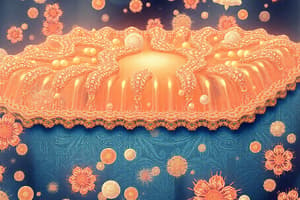Podcast
Questions and Answers
What is the role of cholesterol in cell membranes?
What is the role of cholesterol in cell membranes?
- It facilitates simple diffusion of molecules.
- It acts as a carrier protein for amino acids.
- It increases the permeability of the membrane.
- It restricts movement of other molecules within the membrane. (correct)
Which of the following best describes facilitated diffusion?
Which of the following best describes facilitated diffusion?
- The random movement of all molecules in a solution.
- Transport that occurs through channel or carrier proteins. (correct)
- Movement of water through a semi-permeable membrane.
- A process that uses ATP to transport molecules.
How does the presence of protein channels and carriers affect transport across membranes?
How does the presence of protein channels and carriers affect transport across membranes?
- They enhance the ability to quickly transport substances. (correct)
- They are only relevant in the case of simple diffusion.
- They slow down all types of transport processes.
- They have no significant impact on transport mechanisms.
What is a characteristic feature of the phospholipid bilayer?
What is a characteristic feature of the phospholipid bilayer?
Which type of transport involves the hydrolysis of ATP?
Which type of transport involves the hydrolysis of ATP?
What is the significance of increased surface area in specialized cells?
What is the significance of increased surface area in specialized cells?
In what way is osmosis defined?
In what way is osmosis defined?
What is the expected viewing appearance of the phospholipid bilayer under an electron microscope?
What is the expected viewing appearance of the phospholipid bilayer under an electron microscope?
Flashcards
Cell Membrane Structure
Cell Membrane Structure
A phospholipid bilayer with embedded proteins, glycoproteins, and glycolipids, forming a selectively permeable barrier.
Fluid Mosaic Model
Fluid Mosaic Model
A model describing the cell membrane as a fluid structure with proteins embedded or attached to a phospholipid bilayer.
Phospholipid Bilayer
Phospholipid Bilayer
A double layer of phospholipid molecules forming the basic structure of cell membranes.
Hydrophobic Tail
Hydrophobic Tail
Signup and view all the flashcards
Hydrophilic Head
Hydrophilic Head
Signup and view all the flashcards
Simple Diffusion
Simple Diffusion
Signup and view all the flashcards
Facilitated Diffusion
Facilitated Diffusion
Signup and view all the flashcards
Carrier Protein
Carrier Protein
Signup and view all the flashcards
Channel Protein
Channel Protein
Signup and view all the flashcards
Osmosis
Osmosis
Signup and view all the flashcards
Active Transport
Active Transport
Signup and view all the flashcards
Co-transport
Co-transport
Signup and view all the flashcards
Study Notes
Cell Membranes - Structure
- Cell membranes have a fluid mosaic structure
- Phospholipids form a bilayer
- Phospholipids have a hydrophilic head and hydrophobic tails
- Proteins are embedded in the bilayer, carrying out various roles
- Cholesterol affects membrane fluidity
- Glycoproteins and glycolipids aid in cell recognition and signaling
- Membrane components move and change their arrangement constantly
Phospholipid Bilayer
- Main component of the cell membrane
- Composed of small polar molecules
- Hydrophilic head (phosphate group) interacts with water
- Hydrophobic tails (fatty acid chains) repel water
- Arrangement in water creates a bilayer
- Bilayer structure is approximately 7-10 nm thick
The Fluid Mosaic Model
- Fluid - phospholipids and proteins can move within the bilayer
- Mosaic - membrane is studded with proteins resembling a mosaic
- Components include phospholipids, cholesterol, proteins, glycoproteins, and glycolipids
Membrane Proteins
- Intrinsic proteins span the entire bilayer, often acting as channels or carriers
- Extrinsic proteins are embedded on one side, possibly acting as enzymes or coenzymes
- Glycoproteins have sugar groups attached, involved in cell recognition and signaling
- Glycolipids have sugar groups linked to lipids, also involved in cell recognition and signaling
- Cholesterol maintains membrane stability and controls fluidity
Other Membrane Components
- Cholesterol regulates membrane fluidity and permeability
- Lipids and carbohydrates form glycolipids and glycoproteins, essential for cell recognition and signaling
Transport Across Membranes
- Cell membranes control entry and exit of substances
- Mechanisms include simple diffusion, facilitated diffusion, osmosis, active transport and co-transport
Studying That Suits You
Use AI to generate personalized quizzes and flashcards to suit your learning preferences.




